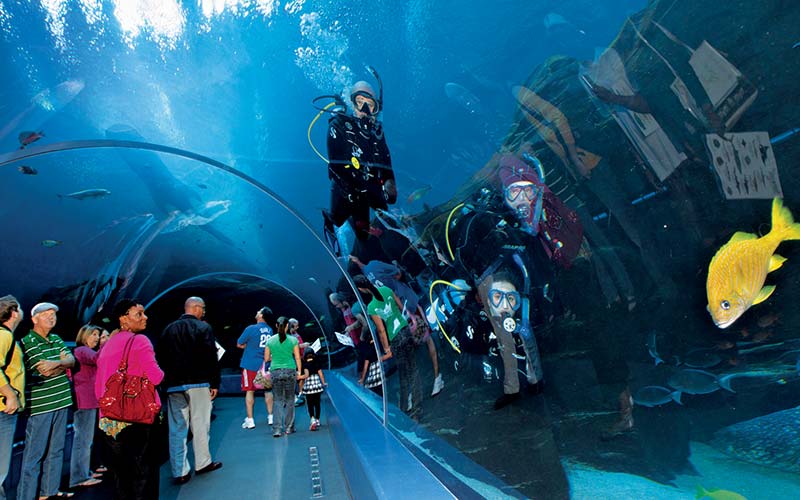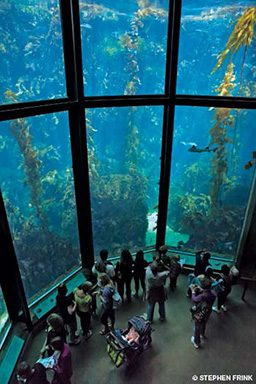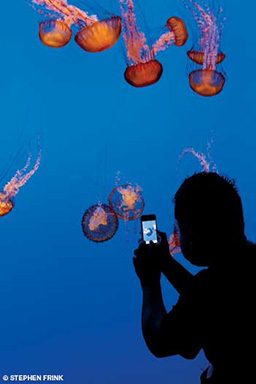In the world of recreational diving, common safety hazards include temperature, depth, environmental conditions and decompression stress. In the world of aquatic animal husbandry, the hazards divers face are somewhat different and include marine mammals, sharks and other fish, nets, heavy equipment and other aspects of the enclosed diving environment. In aquariums and marine-mammal facilities around the world, divers are employed to help maintain the premises daily.
A variety of jobs exist in these establishments: Aquarists feed fish, marine-mammal trainers conduct shows and training sessions, and water-quality and life-support technicians perform routine inspections and clean the exhibits and pools. All these people are trained as open-water divers, but when they enter this unique world they get additional training. Not only do they learn new underwater and surface skills, these divers also learn how to apply old skills in new ways. Additionally, they must become familiar with new rules and procedures.
These facilities are regulated by governing agencies, such as the Occupational Safety and Health Administration (OSHA) in the U.S., and often elect to comply with standards or protocols recommended by other organizations, such as the Association of Zoos and Aquariums (AZA) or the American Academy of Underwater Sciences (AAUS). The intent of the regulations and suggested practices is, of course, to promote the safety of all involved — employees, animals, volunteers and guests.

Oversight and Compliance
Each facility has its own dive-safety manual, dive logs and equipment maintenance records. These records are kept along with an individual file on each diver, which contains certification information, medical and safety training records. Every dive program also has a dive control board made up of divers and managers who work together to ensure a safe program, but daily operations of the dive program are typically overseen by one person — a lead diver, aquatics manager or dive safety officer (DSO). This essential role exists to promote safety, ensure compliance with all applicable standards and maintain training records for each member of the dive staff. The DSO is also responsible for keeping the organization’s dive-safety manual current.
Generally, dive programs at marine-animal facilities in the U.S. follow OSHA’s guidelines for commercial diving operations. Originally intended for commercial divers in open water, these regulations are the backbone of professional dive safety; however, each facility may have its own standards for becoming a staff diver. These standards pertain to divers’ level of certification, hours under water, diving experience and medical fitness. Facility dive programs may include volunteer programs, part-time dive staff who perform other jobs in the organization and/or full-time dive crews.
Getting Involved

Volunteering or becoming employed with one of these programs is not as difficult as you might expect. Requirements may be academic in nature (a college degree in a particular field, for example) or may consist of experience or skill in carpentry, plumbing or electrical or mechanical work. The interview would likely include a review of one’s diving experience. The level of certification required will vary based on the duties you’re interested in performing. On-the-job training would include pre- and postdive procedures, dive protocols, equipment maintenance and cleaning and safety training.
Even recreational diving can be hard on the body, and being underwater every day can be even more strenuous, physically and mentally. Thus, every diver should be in good health. To confirm fitness to dive, working divers must undergo an evaluation by a doctor trained in dive medicine. Some facilities also require a swim test, but a lifeguard certification (or perhaps your dive certification) might serve as a confirmation of swimming ability.
One of the first steps for a diver who has begun working at an aquarium or other animal-husbandry facility is an orientation dive with a senior diver or the DSO. During this dive the new diver would be tested on basic skills to demonstrate competence and confidence in the water. Skills evaluations help ensure all divers are held to the same standard while also refreshing skills and adapting them, if necessary, to the facility’s unique environment. Regulator removal, for example, could help prepare divers for getting a second-stage hose caught on a valve handle or a piece of decorative coral. After a satisfactory evaluation, the diver can move along his chosen path.
Aquarium Exhibit Diving
A diver might choose aquarium exhibit diving. One of the most engaging aspects of aquarium diving is the variety of species available for observation and interaction. You can see animals on a single dive that might take years of open-water diving to see. The primary hazards associated with this path are stingrays, sharks and other types of fish as well as the confined nature of the environment. Equipment and skills used include underwater communication systems, chainmail protective suits and aquatic-animal interaction while feeding and cleaning exhibits. Diving with surface-supplied air has become increasingly popular because divers are not limited by air supply and bulk is reduced compared to scuba gear.
More aquariums are becoming interactive facilities in which divers speak directly to guests from within exhibits, guests can dive in the exhibits, and live feeding shows occur. These facilities often seek employees and volunteers with rescue-diver certification and training in first aid, CPR and oxygen administration. Some aquariums run courses for their staff members; for example, a facility might offer training in hazardous marine life injuries that covers all of its potentially dangerous animals.
Marine Mammal Training

One of the most sought-after careers in animal care is marine-mammal training. As a marine-mammal trainer, your focus is on behavior. Dolphins, whales, sea lions and walruses can create a variety of safety concerns for the working diver. Working with these animals requires the right knowledge and experience; educated observation of their behavior makes for safer diving.
Just like any other animal, marine mammals may act aggressively at times. Because water is their natural environment and not ours, divers must always respect these animals. Divers should know their own limits and the proper responses to aggressive behavior. This may mean leaving the environment if a precursor to aggression is noted. When nets are used as training tools to teach animals to move from one pool to another, divers must know how to properly deploy, operate and avoid entanglement in them.
Underwater interactions between marine mammals and guests have become popular, so animal-trainer divers may also find themselves working as safety divers. For these roles, advanced training in dive safety or dive-emergency management (e.g., rescue diver or lifeguard certification, first aid, CPR or oxygen administration) may be required.
Life-Support and Water-Quality Diving
Life-support diving and water-quality diving feature one overarching goal: keeping the environment clean and operating. It can get messy. Pool scrubbing, vacuuming, pressure washing and window buffing make up most of the workload. Other aspects of the job include diving in submerged confined spaces such as ozone towers, sand filters, pump vaults and water basins. The hazards associated with this type of diving include bounce diving (frequent ascending and descending), inhalation of toxic gases such as ozone or chlorine, dark environments with limited visibility and movement in proximity to sensitive equipment. Because of these risks, OSHA requires additional training for this type of diving. In addition to first aid, CPR and oxygen administration, this training usually consists of confined-space entry, fall protection, lockout/tagout and personal protective equipment.
These dives are not generally suitable for inexperienced divers; they require a greater level of experience in water and a high degree of comfort in the water. Though these dives can be hazardous, they can also be exciting, offering a type of dive that combines elements of night diving, drift diving and wreck or cavern diving.
Although these three types of dive jobs are the most prevalent at animal-husbandry facilities, divers may also be required to conduct inspections, testing, training or skill review. But no matter the purpose of the dive, safe practices are always at the forefront of diving operations. As recreational divers use the buddy system, divers in aquariums always work in teams consisting of other divers and/or surface tenders.
Although diving is only one small part of this business, it’s an essential part, and regulations, standards, safety training and vigilance are mandatory elements. As all members of a diving program maintain their skills and meet the industry’s (and the facility’s) established standards of safe diving, all can enjoy future dive adventures inside and outside of aquariums.
© Alert Diver — Q2 Spring 2013